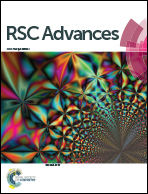Ambient-temperature fabrication of melamine-based sponges coated with hydrophobic lignin shells by surface dip adsorbing for oil/water separation†
Abstract
A melamine-based sponge with a highly hydrophobic surface, high porosity and low density, is facilely fabricated through a simple surface adsorption technique that consisted of dipping in a tetrahydrofuran solution containing renewable alkali lignin and carbodiimide-modified diphenylmethane diisocyanate. The entire process can be performed at ambient temperature without consuming a large amount of energy. The resultant sponge, coated with a highly hydrophobic lignin-based shell, retained most of the inner space for the storage of oil and organic liquids and was similar to a sealed container with highly hydrophobic walls. The prepared sponge, with a highly hydrophobic surface (water contact angle of 145.9°), exhibited excellent absorption capacities for organic liquids, with a volume-based absorption capacity of up to 98% of its original volume. Moreover, the absorbed oil can be recovered by squeezing the oil-absorbed sponge with a good compressibility, which maintained above 86.96% of the mass-based absorption capacity even after 100 absorption/squeezing cycles. Due to their low cost, simple fabrication process and high oil/water separation performance, melamine-based sponges coated with lignin have a great potential in applications for oil spill cleanup and organic contamination removal.



 Please wait while we load your content...
Please wait while we load your content...